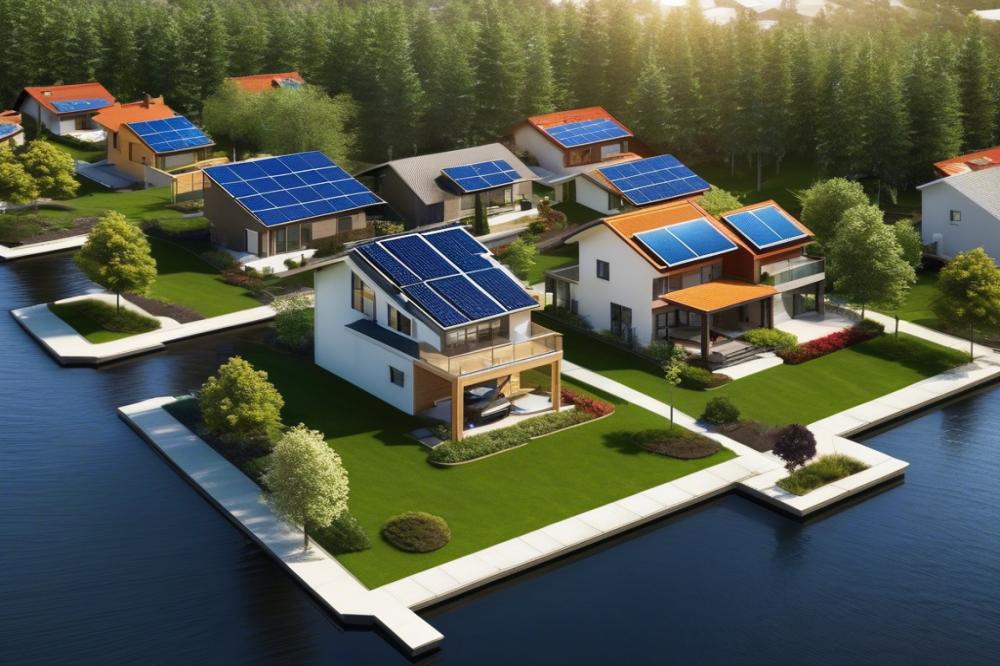Introduction
Canada is harnessing the power of the sun in a big way. Many homeowners are considering solar energy as a viable option for their energy needs. The country’s vast landscapes and varying climates can support solar power generation. This makes it a strong candidate for renewable energy sources. In recent years, energy policies have been designed to encourage installations of solar panels. These policy changes reflect a growing commitment to sustainability and energy independence.
homeowners across Canada can benefit from the shift towards solar energy. Many are not only looking to reduce their power bills but also to make a positive environmental impact. A major perk includes the ability to sell excess energy back to the grid. This can create a new revenue stream that helps offset installation costs. Government incentives often assist with financing options, as well.
The environmental benefits of solar power cannot be overstated. The use of renewable energy sources, such as solar, contributes to a decrease in carbon emissions. This shift can lead to cleaner air and a healthier planet. Homeowners engaged in selling solar energy can play a significant role in this ecological transition. By opting for solar panels, they contribute to a more sustainable energy future.
However, there are several factors to consider before making this jump. Understanding grid connection processes and solar financing options is crucial. Potential users should evaluate local government incentives and the specific installation costs. All these elements play a role in making informed decisions. With the right knowledge, homeowners can take charge of their energy consumption and financial savings.
Understanding solar power Canada

Definition of Solar Power and Its Relevance
Solar power is the energy harnessed from the sun’s rays. This renewable energy source holds significant importance in today’s world. Homeowners can reduce their electricity bills while contributing to environmental preservation. Clean energy options are increasingly relevant as the effects of climate change become clearer. Utilizing solar energy lessens reliance on fossil fuels. This shift also promotes energy independence for many households across the nation.
Types of Solar Panels Available
Various types of solar panels exist to meet different needs. Monocrystalline panels are popular due to their efficiency. They typically take up less space and produce more power. Polycrystalline options are often cheaper but may require more area to produce the same energy. Thin-film panels offer flexibility, making them suitable for unique installations. Each type comes with its own set of installation costs. Evaluating these differences helps homeowners make informed choices about the right solar solution for their homes.
Overview of Renewable Energy Trends in Canada
Renewable energy trends in Canada show a strong growth trajectory. Government incentives play a crucial role in this transformation. Many provinces provide financial support to encourage solar installations. Policies aimed at reducing carbon emissions align with the push for cleaner energies. The demand for solar financing options has increased as more homeowners look to adopt this technology. Grid connection processes are becoming more streamlined, making it easier for new systems to integrate with existing infrastructure. Environmental benefits extend beyond lower bills; they include significant reductions in greenhouse gas emissions. Change is happening, and many homeowners are eager to join this movement toward a sustainable future.
Installation of Solar Panels

Factors to Consider Before Installation
Homeowners should carefully consider several factors before deciding to install solar panels. The orientation and pitch of the roof play a significant role in how much sunlight the panels can catch. Availability of sunshine throughout the year is another key aspect; some regions see more sun than others. Additionally, local energy policies impact the feasibility of solar installations. Understanding the potential for energy independence is crucial for many homeowners, as it helps assess long-term benefits.
Costs Associated with Solar Panel Installation
Installation costs can vary widely based on the size of the system and specific needs. Homeowners often face both initial costs and ongoing expenses. Despite the upfront investment, many find that solar financing options, such as loans and leases, make the process more accessible. Don’t forget about potential government incentives that can help offset installation costs. These can include tax credits or rebates that significantly reduce the overall financial burden.
Choosing the Right Provider and Installation Process
Selecting the right provider is essential for a successful solar installation. Research local contractors to find a reputable company with experience and solid reviews. Asking for references can also help in making an informed choice. During the installation process, communication between the homeowner and the installation team is key. Clarity about the timeline and grid connection requirements ensures a smoother experience. Understanding the entire process beforehand can help mitigate surprises and ensure satisfaction with the final results.
The benefits of switching to renewable energy are numerous. By investing in solar panels, homeowners contribute to environmental benefits while potentially saving on long-term energy costs. Making an informed decision can lead to a brighter, more sustainable future.
Energy Policies and Regulations
Current energy policies in Canada shape the landscape for homeowners interested in solar power. The government supports renewable energy through various incentives. These include rebates that help reduce installation costs for solar panels. Many provinces have set goals to increase the use of clean energy. Policies vary significantly from one region to another.
Provincial differences in regulations
Each province has its own set of regulations regarding solar energy. For instance, Ontario offers a feed-in tariff program that allows homeowners to sell excess energy back to the grid. British Columbia, on the other hand, focuses on net metering, which credits homeowners for the renewable energy they produce. Alberta also has unique policies favoring private ownership of solar systems. These differences can impact how quickly homeowners can start using solar power.
Grid connection requirements for homeowners
Connecting to the grid is a key consideration for homeowners planning to install solar panels. It is crucial to comply with local codes and standards. Each province has specific conditions that must be met for grid connection. Some regions may require permits before moving forward with installation. Additionally, homeowners should explore solar financing options to accommodate the upfront costs.
Understanding energy policies is important for energy independence. Solar power can lead to significant savings on utility bills. Environmental benefits are also considerable, as families reduce their carbon footprints. Keeping informed about government incentives can greatly enhance the appeal of going solar.
Government Incentives for Solar Power
Installing solar panels presents an opportunity for homeowners to embrace renewable energy. Governments at both federal and provincial levels offer financial incentives to promote this shift. Understanding these incentives can significantly reduce installation costs and encourage more families to consider solar options.
Overview of Financial Incentives Available
Various programs exist to support homeowners interested in solar power. Some offer direct rebates on installation costs, while others provide grants specifically designed for solar initiatives. In Canada, policies aim to make solar energy more accessible and affordable for everyone. Many homeowners may qualify for funding that can offset substantial portions of their installation expenses.
Tax Credits and Rebates for Solar Installations
Homeowners can benefit from tax credits that reduce the overall tax burden. These credits often apply to expenses related to solar panel purchases and their installation. Additionally, rebates are available that directly reduce upfront payments. These financial tools can be a game-changer, allowing families to invest in solar systems without taking a large financial hit. Some provinces have their unique programs that further encourage homeowners to pursue solar financing.
Impact of Incentives on Overall Costs
Overall, government incentives significantly impact installation costs. When calculating the total expenses for solar power setups, consideration of these rebates and credits is crucial. The reduction in net expenses for homeowners who take advantage of these programs can be substantial. Many find that these financial supports make solar energy a feasible option, enhancing their energy independence while contributing to environmental benefits. Homeowners can lower their economic burdens while investing in a sustainable future.
Financing Options for Homeowners
Navigating solar financing options can seem overwhelming for many homeowners. Understanding the various methods of funding solar panels is crucial to making an informed decision. With renewable energy gaining traction, many are looking to harness its benefits while managing costs. There are several pathways available to make solar energy accessible.
Understanding Solar Financing Options
The landscape of solar financing in Canada consists of various models, each catering to different needs. Many homeowners consider outright purchases, which allow for full ownership of the solar system. However, the initial installation costs can be quite significant. This upfront expenditure may not be feasible for everyone.
Loans are another option. They allow families to borrow money to pay for solar panel installation. Monthly installments are then paid over time, often at a lower interest rate than other loans. This method enables homeowners to spread out the cost while still benefiting from renewable energy.
Loans and Leasing Arrangements for Solar Panels
Many homeowners also have the choice to lease solar panels. Leasing allows them to install solar systems with little or no upfront cost. Instead of ownership, the leasing company retains ownership of the system. This arrangement can simplify maintenance and repairs as the leasing company often handles those responsibilities.
Moreover, some may opt for a Power Purchase Agreement (PPA). In this scenario, homeowners pay for the electricity produced by the solar panels instead of paying for the equipment itself. This can be an appealing option for those concerned about installation costs but still want to benefit from solar energy. Evaluating these options is essential before making a decision.
Evaluating Long-Term Savings Versus Upfront Costs
When deciding between various financing methods, it’s important to analyze long-term savings and upfront costs. Reviewing energy policies can help clarify how much a homeowner may save over the years. Although the initial costs may be high, many homeowners recoup their investment through reduced energy bills.
Incentives provided by the government can also influence choices. Various programs help offset the investment, making solar solutions more attractive. Homeowners should look into how these incentives relate to installation costs. Combining rent, loans, or leasing with governmental support can lead to significant savings.
Additionally, the potential environmental benefits should not be overlooked. Adopting solar energy contributes to energy independence, reducing reliance on fossil fuels. This shift not only helps the planet but may also provide peace of mind about energy costs in the future. Carefully assessing financial and environmental impacts is wise when considering solar financing.
Staying informed about grid connection policies is another key element. Local regulations may impact how homeowners connect their solar systems to the existing grid. Some may even earn credits for excess energy produced. Understanding these aspects can guide homeowners in making a well-rounded decision about their solar power journey.
Selling Excess Solar Power
How to Measure Energy Production
Measuring the energy production of solar panels is essential for homeowners. A solar energy system typically includes a solar inverter that tracks how much electricity is generated. Homeowners can check their production using monitoring apps provided by installers. Many systems also come with digital displays that show real-time data. Understanding these figures helps in planning how much energy can potentially be sold.
Options for Selling Surplus Energy
Homeowners have several options for selling excess electricity. One of the most common strategies is through net metering. This concept allows individuals to send surplus energy back to the grid in exchange for credits on future electricity bills. Another option is participating in feed-in tariff programs. Such programs are set by local governments to encourage renewable energy adoption. Through feed-in tariffs, homeowners can receive payments for the energy they supply, often at a higher rate than retail electricity costs.
Understanding Net Metering and Feed-in Tariffs
Net metering is a simple system. Homeowners receive bill credits for the electricity their solar panels generate. When solar production is high, homeowners can offset their energy consumption when production declines, such as during the evening. This offers a practical approach to energy independence.
Feed-in tariffs, on the other hand, work differently. They guarantee compensation for every kilowatt-hour produced, regardless of consumption. This can provide a stable income, depending on local energy policies. Government incentives often support these programs, encouraging more people to consider solar energy.
Navigating the regulations around net metering and feed-in tariffs can be complex. Homeowners should consult their utility company for specific details regarding grid connection and the local framework. Understanding installation costs and solar financing options is vital for a successful investment. Supporting renewable energy also brings environmental benefits, contributing to a cleaner planet.
Selling surplus energy not only helps families save money but also promotes the use of sustainable resources. As more Canadians turn to solar power, these systems could significantly impact the energy landscape.
Environmental Benefits of Solar Power
Positive Effects on the Environment
Using solar energy brings significant environmental advantages. It helps reduce greenhouse gas emissions that contribute to global warming. Unlike fossil fuels, solar panels produce clean electricity without harmful pollutants. The transition to renewable energy sources can lead to cleaner air and a healthier planet. This makes a difference for wildlife and natural ecosystems, which are often affected by pollution.
Role of Solar Energy in Combating Climate Change
Climate change is a pressing issue. Solar power plays a vital role in addressing this challenge. By harnessing the sun’s energy, homeowners can decrease their reliance on non-renewable sources. This shift can reduce carbon footprints, making a measurable impact on the planet’s health. Government incentives encourage this transition, allowing more people to participate in a greener future.
Contribution to Energy Independence for Homeowners
Solar energy also supports energy independence. Homeowners who install solar panels can generate their own electricity. This reduces dependence on the grid and fluctuating energy costs. With the right solar financing options, the initial installation costs become more manageable. Gaining energy independence can provide peace of mind, especially during energy shortages or price hikes. Ultimately, using solar power represents a step towards a more sustainable lifestyle.
Final Thoughts on Solar Power in Canada
To recap, solar energy offers a sustainable and cost-effective choice for homeowners in Canada. The benefits are clear: lower electricity bills, increased property value, and a positive impact on the environment. Knowledge about available rebates and tax incentives can significantly assist in making this transition smoother.
Considering all of these advantages, exploring solar power may be a wise choice. Many studies show that investing in solar panels leads to long-term savings. It is also a chance to contribute to the fight against climate change. Making the switch not only benefits individual households but supports the community and the planet.
The future of solar energy seems brighter than ever. As technology improves, the efficiency of solar panels will only increase. Anticipating continued government support, homeowners can feel confident in the growing viability of solar options. Transitioning to renewable energy sources might soon become the standard for households across the nation.
Embracing solar technology today ensures a cleaner, greener tomorrow. The opportunities are plentiful, and the call to action is clear. Jumping into the world of solar energy isn’t just an investment; it’s a commitment to a healthier environment for generations to come.



